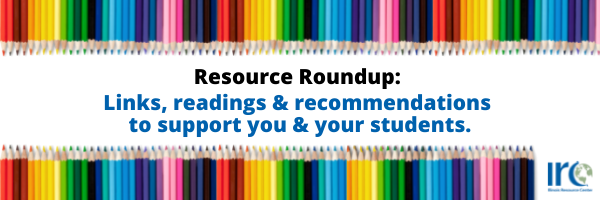Over the past few weeks, the IRC has asked members of our community to nominate Illinois teachers working with multicultural, multilingual students who are going above and beyond, and now, we’re celebrating them and highlighting their work. Keep an eye out for these features in the coming months – and if you’d like to nominate someone, email leanet@cntrmail.org. Next up is Veronica Garcia-Martinez, a fifth grade teacher in DeKalb Community School District 428.
Says AJ Crook, who nominated her: “Veronica took over for a fifth grade one way dual language teacher who quit in October. Veronica has really focused on developing our students’ identities as multilingual/cultural beings and celebrating their linguistic diversity. She has inspired students to love themselves and their awesome identities.”
The first guiding principle Veronica Garcia-Martinez for any classroom she steps into is simple—set the bar high.
When taking over for a fifth-grade one-way dual language classroom in the middle of the school year, Garcia-Martinez says she knew her students wanted to impress her and show that they could reach the goals they had set. “If you set the bar low, they’re going to think you think less of them,” she says. “I told them, ‘I know you can do it. Let’s find our learning style and make it happen.’”
To ensure students could achieve their goals, Garcia-Martinez began working with them to instill confidence in participation. She noticed a lot of her EL students were apprehensive to participate in class because they were insecure about their grasp on the language or speaking with an accent. She wanted students to embrace their linguistic heritage and experiences, and encouraged them to speak Spanish or translanguage if it helped them better express themselves in the classroom. “Bilingualism is life,” she says. “If their life is two languages, then we should incorporate that into every aspect of their learning.”
One tactic that Garcia-Martinez found helpful in encouraging her students was “readers theater,” using dramatic read-alouds to gain language skills in an imaginative and interactive way. By encouraging the students to use their expressions, their accents and showcase their personalities to bring the characters to life, students went from never participating or wanting to read to her to her having to limit how much they could do in one day. She says students understand acting from what they’ve seen on TikTok and YouTube, and even without enough roles, students could become directors and producers and help each other.
Another key to the success of Garcia-Martinez’s classroom was the collaboration around classroom norms. At the beginning of the school, she sought input from the students to establish community agreements for the year together. For example, she didn’t want the students chewing gum, but agreed to allow it based on the community norms discussion, but if gum ended up on the floor, this would be revoked. This lasted until two weeks before school ended, which Garcia-Martinez considers a success—creating the agreements together instilled a sense of collective responsibility around the space for her students. “The classroom belongs to everybody, including the students,” she says. “We have to empower students to use their voice, to question things and feel like they have ownership of their environment.”
Garcia-Martinez encourages her peers in education to embrace their bilingual students and try to understand and honor their cultures and experiences. She says that embracing translanguaging and honoring her students’ languages improved their confidence in the classroom, and she hopes she was able to help her students realize their worth. “On my very last day, a student asked me, ‘Do you really think I could be President,’ and I said, ‘Of course,’” Garcia-Martinez says. “I accomplished a small goal of showing them there is no limit to what they can do or achieve.”



